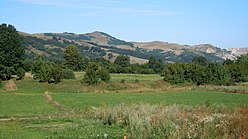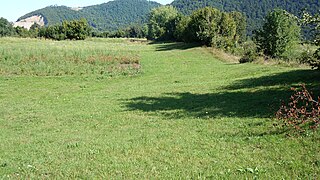| Resculum | |
|---|---|
 View from South-East View from South-East | |
 | |
| Alternative name(s) | Rucconium |
| Known also as |
|
| Founded during the reign of | Trajan |
| Founded | 2nd century AD |
| Abandoned | c. 4th-5th century AD |
| Attested by | Tabula Peutingeriana |
| Place in the Roman world | |
| Province | Dacia |
| Administrative unit | Dacia Porolissensis |
| Administrative unit | Dacia Superior |
| Limes | Porolissensis |
| Directly connected to | |
| Structure | |
| — Stone structure — | |
| Size and area | 122 m × 213 m (2.6 ha) |
| — Wood and earth structure — | |
| Size and area | 130 m × 203 m (2.6 ha) |
| Stationed military units | |
| — Cohorts — | |
| Location | |
| Coordinates | 46°53′08″N 22°53′05″E / 46.885694°N 22.884611°E / 46.885694; 22.884611 |
| Altitude | c. 527 m |
| Place name | Grădiște |
| Town | Bologa |
| County | Cluj |
| Country | |
| Reference | |
| RO-LMI | CJ-I-s-A-06975 |
| RO-RAN | 59069.01 |
| Site notes | |
| Recognition | |
| Condition | Ruined |
| Excavation dates |
|
| Archaeologists |
|
Resculum or Rucconium was an ancient Roman fort in the Roman province of Dacia. The ruins are located near the village of Bologa, Cluj county, at the confluence of river Sebeș with river Criș, on the promontory of a hill. A vicus developed close to the castrum. An inscription cited by Károly Torma but now lost named the associated civil settlement as Anartorum.
It was the southwestern start point of Limes Porolissensis, from which a road led to Porolissum. An advanced outpost, 30km down the Crișul Repede valley, at Negreni, was connected to the fort.
History
Three phases of the castra are known:
1. In the early phase, right after Trajan's Dacian Wars, the castrum was made of earth and timber. Initially Cohors I Ulpia Brittonum miliaria equitata was stationed there but it was later moved to Porolissum and replaced by Cohors II Hispanorum (renamed Cohors II Hispanorum scutata Cyrenaica equitata).
2. The fort was enlarged a couple of decades later as the presence of Cohors I Aelia Gaesatorum miliaria is also attested at the site.
3. At the beginning of the 3rd century it was rebuilt from stone and reached a size of 133,30x213m. A horreum is attested at the site with a second, smaller logistic building of unknown function also present within the walls. It also manned numerous ancillary structures connected to it such as watchtowers and fortlets.

Gallery
See also
Notes
- ^ "Bologa". Archived from the original on 2012-03-16. Retrieved 2011-08-01.
- Tactică, strategie și specific de luptă la cohortele equitate din Dacia Romană, Petru Ureche
- ^ "Castrul roman de la Bologa - "Grădiște"". National Archaeological Record of Romania (RAN). ran.cimec.ro. 2013-09-09. Retrieved 2014-05-01.
- Deac, Dan (2013-01-01). "Dan Deac, The Toponymy of Dacia Porolissensis. Recent Research and New Approaches". Ephemeris Napocensis XXIII.
- "Repertoriul Arheologic Naţional". ran.cimec.ro. Retrieved 2024-06-15.
- Boragno, Lorenzo (6 January 2022). "The iron of the Empire: the production of iron made military equipment in the province of Dacia (AD 106 - AD 270)" (PDF). HAL. p. 265. Retrieved 19 June 2024.
- Boragno (2022), p. 266.
- ^ Boragno (2022), p. 268.
- Wanner, Robert (2010-07-07). Forts, fields and towns: Communities in Northwest Transylvania from the first century BC to the fifth century AD (Thesis). University of Leicester. p. 127.
- Boragno (2022), p. 268-269.
External links
 Media related to Resculum at Wikimedia Commons
Media related to Resculum at Wikimedia Commons- Castrul roman Bologa - reportaj sapaturi arheologice (in Romanian)
- Roman castra from Romania - Google Maps / Earth
| Limes Dacicus | |
|---|---|
| Alutanus | |
| Transalutanus | |
| Porolissensis | |
| Eastern frontier | |
This Dacia-related article is a stub. You can help Misplaced Pages by expanding it. |

